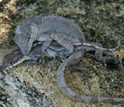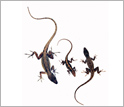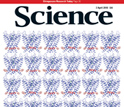News Release 10-053
Small But Mighty Female Lizards Control Genetic Destiny
Mothers win the genetic tug of war by producing more sons with larger fathers and more daughters with smaller fathers

Female anoles, though two to three times smaller than male anoles, may control fertilization.
April 2, 2010
This material is available primarily for archival purposes. Telephone numbers or other contact information may be out of date; please see current contact information at media contacts.
Dartmouth researchers Ryan Calsbeek and Bob Cox study male and female brown anole lizards in the Bahamas. As the researchers point out, one of the most striking features of this species is that the males and females actually look like two entirely different species: the males are two to three times larger than the tiny females, weighing just one to two grams apiece. Their research is detailed in the April 2 edition of the journal Science.
By measuring the lizards' natural and sexual selection, they learned what traits and, by extension, what genes make a high-quality female--i.e. one with high survival and reproductive success. They also learned the traits and genes of a high-quality male are very different from a high-quality female. This is particularly true for body size.
Calsbeek and Cox report their findings in a paper called "Cryptic sex-ratio bias provides indirect genetic benefits despite sexual conflict."The research is supported by the National Science Foundation's division of Environmental Biology in its Directorate for Biological Sciences.
Natural selection favors large males and small females. As lead author Cox puts it, "In an evolutionary sense, what's good for the goose is not always good for the gander." In other words, a double standard is alive and well.
This could present a challenge for females. Mating with a high-quality male in the population is great if he produces sons, but studies of other species have shown that the best males often make the worst daughters. This cancels out the advantage of mating with the best males in terms of daughters' genetic fitness.
But the researchers discovered something remarkable female anoles appear to have solved the evolutionary problem of getting preferred genes to a specific gender. Females mate with several males and then make more sons with the sperm from big males, and more daughters with sperm from small males.
The findings are unique as they actually show sex-ratio bias empowers the mother in an evolutionary sense, giving her an ability to produce sons with sperm from large males that survive better than sons produced with sperm from small males.
"This species has figured out a clever way to pass on genes with gender-specific effects on fitness," said Cox, "Usually, when natural selection pulls genes in different directions from each gender, the species faces an evolutionary dilemma. But these lizards have solved this puzzle, they've figured out how to get the right genes into the right gender."
"As we predicted, the survival of the male offspring increased if they had large fathers," said Calsbeek. "But we found that the survival of the daughers was not influenced by the size of the father. This suggests that the genetic benefits of large size are specific to sons."
In species where males are much larger and more aggressive than females, such as anoles, people often assume that males ultimately have control over mating and fertilization. One interesting implication of the study is that, even though the large males have physical control over mating, it's the tiny females that appear to have control over fertilization. Even when the largest males mate with a female, she may only use their sperm when it is beneficial to her and her offspring.
In the end, this could actually end up benefiting both sexes, because large males will benefit the most when they produce sons, whereas small males will benefit the most when they produce daughters. On the whole, this pattern resolves the genetic tug-of-war over body size by providing a solution that works best for both sexes.
-NSF-
-
A mating pair of brown anole lizards from the Bahamas. Males can be three times larger than females.
Credit and Larger Version -
Female anoles mate and produce more sons with large males and more daughters with small males.
Credit and Larger Version -
The researchers' findings appear in the April 2, 2010 issue of the journal Science.
Credit and Larger Version
Media Contacts
Lisa-Joy Zgorski, NSF, (703) 292-8311, email: lisajoy@nsf.gov
Program Contacts
Nancy J. Huntly, NSF, email: nhuntly@nsf.gov
Principal Investigators
Ryan Calsbeek, Dartmouth, (603) 646-9916, email: ryan.calsbeek@dartmouth.edu
Co-Investigators
Robert M. Cox, Dartmouth, (603) 646-9916, email: robert.m.cox@dartmouth.edu
The U.S. National Science Foundation propels the nation forward by advancing fundamental research in all fields of science and engineering. NSF supports research and people by providing facilities, instruments and funding to support their ingenuity and sustain the U.S. as a global leader in research and innovation. With a fiscal year 2023 budget of $9.5 billion, NSF funds reach all 50 states through grants to nearly 2,000 colleges, universities and institutions. Each year, NSF receives more than 40,000 competitive proposals and makes about 11,000 new awards. Those awards include support for cooperative research with industry, Arctic and Antarctic research and operations, and U.S. participation in international scientific efforts.
Connect with us online
NSF website: nsf.gov
NSF News: nsf.gov/news
For News Media: nsf.gov/news/newsroom
Statistics: nsf.gov/statistics/
Awards database: nsf.gov/awardsearch/
Follow us on social
Twitter: twitter.com/NSF
Facebook: facebook.com/US.NSF
Instagram: instagram.com/nsfgov





